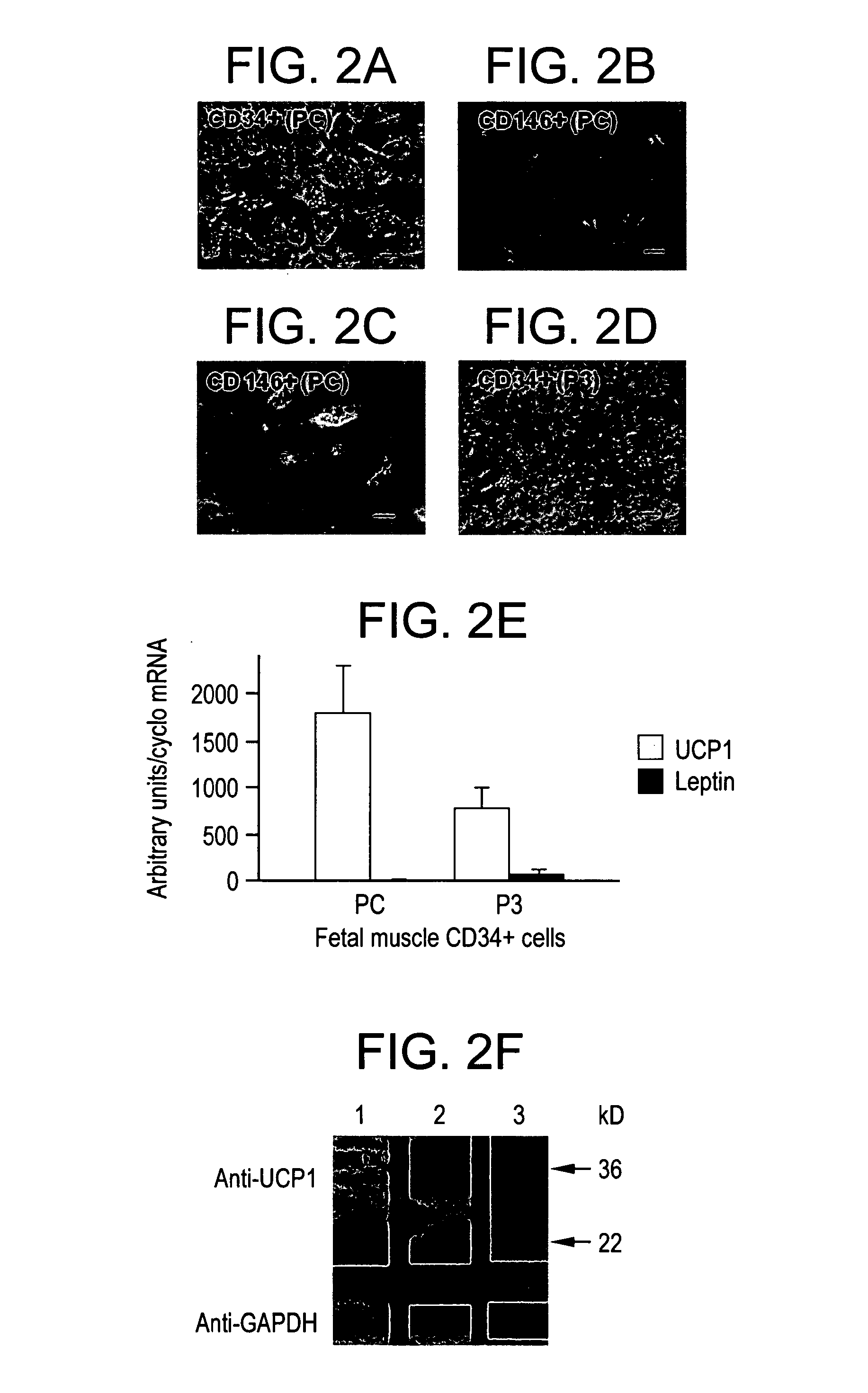Brown Adipocyte Progenitors in Human Skeletal Muscle
- Summary
- Abstract
- Description
- Claims
- Application Information
AI Technical Summary
Benefits of technology
Problems solved by technology
Method used
Image
Examples
example 1
Sorting and Differentiation of Muscle Vascular Cells
[0036]In fetal skeletal muscle, CD34 and CD146 were found, by immunohistochemistry, to be expressed at the surface of endothelial cells and pericytes, respectively, although CD34 was also expressed by cells scattered in the inter-myofibrillar space. FIG. 1(A) shows a small vessel longitudinal section in which CD146+ pericytes (green) surround CD34+ endothelial cells (red). A similar distribution of CD34+ and CD146+ cells was observed in adult skeletal muscle.
[0037]Vascular cells from seven independent fetal muscles (16-24 weeks of gestation) were sorted using multi-color fluorescence-activated cell sorting (FACS). Hematopoietic (CD45+) cells were first gated out, as were myogenic progenitors (CD56+). Then, endothelial cells (CD34+ / CD146−) and pericytes (CD34− / CD146+) were sorted. The CD34+ / CD146− / CD45− / CD56− are designated thereafter as CD34+ cells and the CD34− / CD146+ / CD45− / CD56− as CD146+ cells. FIG. 1(B) shows CD34+ / CD146− and C...
example 2
UCP1 Expression in Cultivated CD34+ Cells
[0040]The remarkable adipocyte-like differentiation of fetal muscle CD34+ cells was an incentive for further characterization. Strikingly, quantitative RT-PCR revealed a high level of UCP1 mRNA in these cells. FIG. 2(E) shows quantitative RT-PCR determination of UCP1 (empty columns) and leptin (gray columns) mRNA expression in CD34+ cells in primary culture (PC) or expanded up to passage 3 (P3). The mean UCP1 mRNA level normalized to cyclophilin A was 1797±510 arbitrary units (i.e., ±s.e.m. of arbitrary values normalized using the corresponding cyclophilin A values; n=4-7), corresponding to a cycle threshold (Ct) of 22 for 25 ng of cDNA in the assay.
[0041]For comparison, the mean UCP1 mRNA level normalized to cyclophilin A in mouse brown adipocytes differentiated in culture was 7715±2649 (n=10) arbitrary units. Therefore, the level of UCP1 mRNA in human CD34+ cells amounted to almost one fourth of that in mouse brown adipocytes in culture. Hu...
example 3
Additional Phenotyping of the CD34+ Cells
[0042]To better characterize the gene expression pattern of the fetal muscle CD34+ cells expanded in culture a gene chip analysis was performed. The levels of expression of several representative gene mRNAs with significant Detection P-Values (p<0.01) are shown in Table 1 and compared with those in human muscle biopsies. The following protein mRNAs were chosen: UCP1 as a reference gene, mitochondrial transcription factor A (mtTFA) and peroxisome-proliferator-activated receptor (PPARγ) and PPARγ coactivator-1α (PGC-1α), which are involved in the control of thermogenesis and mitochondriogenesis, enzymes of the mitochondrial respiratory chain succinate dehydrogenase (SDH) and cytochrome oxidase IV (COX IV), enzymes of the fatty acid degradation pathway, carnitine palmitoyltransferase 1B (CPT1B), acyl-CoenzymeA dehydrogenases long chain (ACAD) and C-4 to C-12 straight chain (ACADM), and the skeletal muscle markers myogenin, myogenic factor 5 (Myf...
PUM
| Property | Measurement | Unit |
|---|---|---|
| Electrical resistance | aaaaa | aaaaa |
| Acidity | aaaaa | aaaaa |
| Basal metabolic rate (total) | aaaaa | aaaaa |
Abstract
Description
Claims
Application Information
 Login to View More
Login to View More - R&D
- Intellectual Property
- Life Sciences
- Materials
- Tech Scout
- Unparalleled Data Quality
- Higher Quality Content
- 60% Fewer Hallucinations
Browse by: Latest US Patents, China's latest patents, Technical Efficacy Thesaurus, Application Domain, Technology Topic, Popular Technical Reports.
© 2025 PatSnap. All rights reserved.Legal|Privacy policy|Modern Slavery Act Transparency Statement|Sitemap|About US| Contact US: help@patsnap.com



